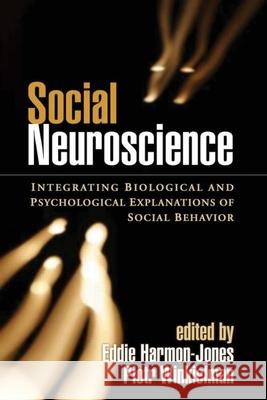Social Neuroscience: Integrating Biological and Psychological Explanations of Social Behavior » książka



Social Neuroscience: Integrating Biological and Psychological Explanations of Social Behavior
ISBN-13: 9781593854041 / Angielski / Twarda / 2007 / 512 str.
Social Neuroscience: Integrating Biological and Psychological Explanations of Social Behavior
ISBN-13: 9781593854041 / Angielski / Twarda / 2007 / 512 str.
(netto: 371,59 VAT: 5%)
Najniższa cena z 30 dni: 386,18 zł
ok. 22 dni roboczych
Bez gwarancji dostawy przed świętami
Darmowa dostawa!
This compelling volume provides a broad and accessible overview of the emerging field of social neuroscience. Showcasing an array of cutting-edge research programs, leading investigators present new approaches to the study of how the brain influences social behavior, and vice versa. The contributors discuss the theoretical advantages of taking a social neuroscience perspective and analyze what their findings reveal about core social psychological phenomena. Essential topics include emotion, motivation, attitudes, person perception, stereotyping and prejudice, and interpersonal relationships.
Obwoluta
The past decade has witnessed great progress in identifying the physiological and neural mechanisms underlying social behavior. This volume brings together many of the leaders of the nascent field of social neuroscience to describe their groundbreaking work in this area. The editors have done a superb job of assembling a broad and representative slate of state-of-the-art chapters. This volume will be valuable for the increasing number of advanced undergraduate and graduate courses focusing on the neurobiology of social behavior, as well as for social and personality psychologists seeking an excellent introduction to the area. Highly recommended.--Todd F. Heatherton, PhD, Champion International Professor, Department of Psychological and Brain Sciences, Dartmouth College
For students unfamiliar with the field, Social Neuroscience provides an accessible overview of the major topics of study and makes a strong case for the need for more research on the physiological and neurological bases of social behavior. In the classroom, this book would be beneficial to advanced undergraduates or graduate students interested in either social psychology or cognitive/behavioral neuroscience.--Sarah Wood, PhD, Department of Psychology, University of Wisconsin-Stout
James Watson once said, 'there are only molecules; everything else is sociology.' His tongue-in-cheek arrogance reminds us of the great gulf that once separated the 'two cultures' of humanities and science. In the last decade this gap is successfully being bridged by social neuroscience. This fine edited volume presents a readable, comprehensive overview of this exciting new field.--V. S. Ramachandran, MD, PhD, Center for Brain and Cognition, University of California, San DiegoI. Introduction
_x000D_1. A Brief Overview of Social Neuroscience, Eddie Harmon-Jones and Piotr Winkielman
_x000D_II. Emotion Processes
_x000D_2. The Importance of Emotion–Social Cognition Interactions for Social Functioning: Insights from Orbitofrontal Cortex, Jennifer S. Beer
_x000D_3. Neurobiology of Emotion Recognition: Current Evidence for Shared Substrates, Andrea S. Heberlein and Ralph Adolphs
_x000D_4. Ten Years of Research with the Trier Social Stress Test—Revisited, Brigitte M. Kudielka, Dirk H. Hellhammer, and Clemens Kirschbaum
_x000D_5. I Know How You Feel: Social and Emotional Information Processing in the Brain, Catherine J. Norris and John T. Cacioppo
_x000D_6. How Thinking Controls Feeling: A Social Cognitive Neuroscience Approach, Kevin N. Ochsner
_x000D_III. Motivation Processes
_x000D_7. Asymmetrical Frontal Cortical Activity, Affective Valence, and Motivational Direction, Eddie Harmon-Jones
_x000D_8. Reward: Neural Circuitry for Social Valuation, Brian Knutson and G. Elliott Wimmer
_x000D_9. A Biobehavioral Model of Implicit Power Motivation Arousal, Reward, and Frustration, Oliver C. Schultheiss
_x000D_10. Vigilant and Avoidant Responses to Angry Facial Expressions: Dominance and Submission Motives, Jack van Honk and Dennis J. L. G. Schutter
_x000D_IV. Attitudes and Social Cognition
_x000D_11. Attitudes and Evaluation: Toward a Component Process Framework, William A. Cunningham and Marcia K. Johnson
_x000D_12. A Social Cognitive Neuroscience Model of Human Empathy, Jean Decety
_x000D_13.How Dynamics of Thinking Create Affective and Cognitive Feelings: Psychology and Neuroscience of the Connection between Fluency, Liking, and Memory, Tedra A. Fazendeiro, Troy Chenier, and Piotr Winkielman
_x000D_14. The X- and C-Systems: The Neural Basis of Automatic and Controlled Social Cognition, Matthew D. Lieberman
_x000D_15. An Evolutionary Perspective on Domain Specificity in Social Intelligence, Valerie E. Stone
_x000D_V. Person Perception, Stereotyping, and Prejudice
_x000D_16. Mechanisms for the Regulation of Intergroup Responses: Insights from a Social Neuroscience Approach, David M. Amodio, Patricia G. Devine, and Eddie Harmon-Jones
_x000D_17. Social Cognitive Neuroscience of Person Perception: A Selective Review Focused on the Event-Related Brain Potential, Bruce D. Bartholow and Cheryl L. Dickter
_x000D_18. Social Neuroscience and Social Perception: New Perspectives on Categorization, Prejudice, and Stereotyping, Tiffany A. Ito, Eve Willadsen-Jensen, and Joshua Correll
_x000D_VI. Interpersonal Relationships
_x000D_19. Neuropeptides and the Protective Effects of Social Bonds, C. Sue Carter
_x000D_20. The Quiet Revolution of Existential Neuroscience, Marco Iacoboni
_x000D_21. Affiliative Responses to Stress: A Social Neuroscience Model, Shelley E. Taylor and Gian C. Gonzaga
_x000D_22. The Social Neuroscience of Relationships: An Examination of Health-Relevant Pathways, Bert N. Uchino, Julianne Holt-Lunstad, Darcy Uno, Rebecca Campo, and Maija Reblin
_x000D_
Piotr Winkielman, PhD, is an Associate Professor of Psychology at the University of California, San Diego. Dr. Winkielman’s current research focuses on the relation between emotion, cognition, body, and consciousness using psychological and psychophysiological approaches. His research has been supported by the National Science Foundation and the National Alliance for Autism Research. He has served on the editorial boards of the Journal of Personality and Social Psychology and Personality and Social Psychology Bulletin, and is currently Associate Editor of Emotion. In 2005 Dr. Winkielman coedited Emotion and Consciousness.
1997-2025 DolnySlask.com Agencja Internetowa
KrainaKsiazek.PL - Księgarnia Internetowa









